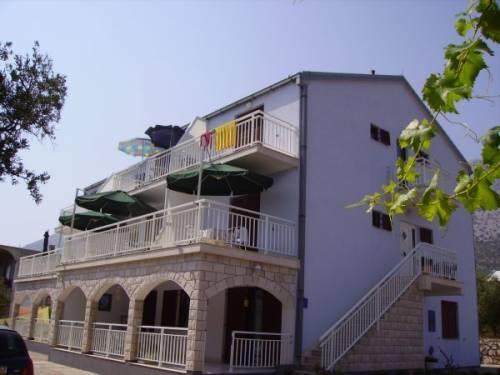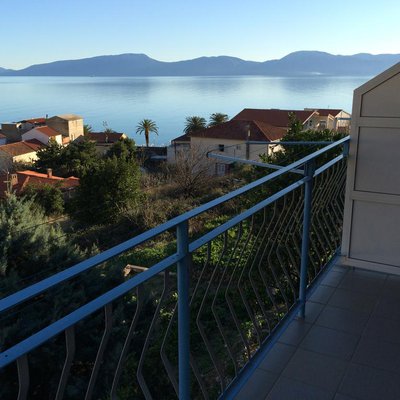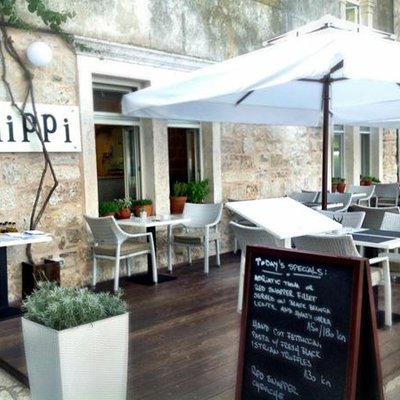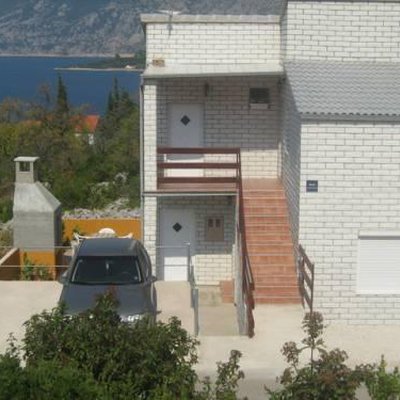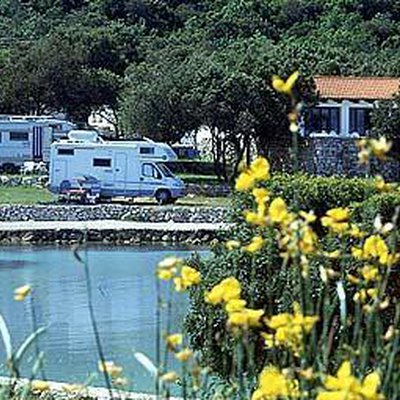Apartments and rooms, peninsula Peljesac
HRVATSKI: Apartmani se nalaze u obiteljskoj kuci u mirnom dijelu mijesta udaljena 350 m od mora i glavne plaze... ENGLISH: Along with the Istrian peninsula, the Peljesac peninsula is one of the largest on the Adriatic coast. It stretches... POLSKI: Orebić to znakomita propozycja aktywnego wypoczynku nad Adriatykiem. Baza ta umiejscowiona na pó³wyspie Peljeœac... DEUTCH: Ein Städtchen an der Südküste der Halbinsel Peljesac. Orebic war einst ein bedeutendes Seeverkehrszentrum...
HRVATSKI:
Apartmani se nalaze u obiteljskoj kuci u mirnom dijelu mijesta udaljena 350 m od mora i glavne plaze. U okućnici se nalaze grill, vanjski tuš, parking i 4 bicikla na usluzi gostima. Kuca je udaljena od trgovine, restorana, caffe bara, liječnika, ljekarne ambulante, super marketa, ribarnice, tržnice, muzeja i centra mijesta od 200 - 800 m te sve ostalo što se potrebno za ugodan boravak turista se nalazi u blizini da se moze obaviti bez automobila.
Apartmani su konforni i opremljeni s sat-tv, terasama kojih neke imaju pogled na more a neke na planinu te neki imaju i klima uredjaje. Mijesto Orebić je bogato raznovrsnim i brojnim plazama tako da svatko moze pronaci sto mu odgovara te se u samom mijestu nalaze razliciti sportski tereni-tenis, kosarka, mali i veliki nogomet a sam krajolik nudi predivne predjele za ljubitelje biciklizma kako brdskog tako i cestovnog. Poluotok Pleljesac je takodjer poznat po autohtonim vrhunski sortama vina poznatim u cijelom svijetu ( Dingac, Plavac Mali , Rukatac, Pošip, Postup, ...) sto zajedno s restoranskom ponudom Peljesac cini izvrsnim mjestom i za istinske ljubitelje vina i dobre kuhinje.
Gostima kuce IRENA mozemo ponuditi posebne popuste u 5,6 i 9 i 10 mjesecu. Popuste odobravamo na kolicinu provedenih dana i broj turista.
Orebić je gradić smješten na jugozapadnoj obali poluotoka Pelješca. To je grad na moru, kojega Pelješki kanal dijeli od otoka Korčule, s kojim je povezan trajektom. Do njega se može doći morskim i kopnenim putem.
Najstariji stanovnici Pelješkoga poluotoka bili su Iliri, kasnije dolaze Grci, pa Rimljani - o čemu nam svjedoče arheološki nalazi. Ljudi toga kraja su se od davnina, obrađujući zemljište, borili sa odronima kamenja koje je nanosila bujica s krševitoga planinskoga sklopa k moru. Odrone su zaustavljali kamenim pregradama i tako oblikovali prostor u ograde i putove između najstarijih naselja.
U prvoj polovici 14. st. Dubrovčani su od bosanskih vladara otkupili Pelješac i razdjelili ga među vlastelom. Oni u 15. i 16.st. sagradiše kuće za nadzor svojih imanja, a zahvaljujući pomorstvu i blizini korčulanskih kamenoloma u 17. st. kuće su se zidale sve čvršće i urednije.
Godine 1835. uz orebićku obalu sagrađena je cesta koja je obrubila naselje, a kroz nju je 1887. godine proveden vodovod. U to doba na obalnoj cesti, u istim razmacima, sagrađene su četiri česme poput atika s profiliranim zabatom središnjega polukružnoga završetka i školjkom pri dnu.
Urbani identitet grada čine upravo ti domovi koji su nastali uz sjevernu obalnu cestu. Oni sa svojim pročeljima i perivojima čine slikoviti perivojni pojas. Sa stražnje strane kuća uglavnom je prostor za gospodarske i poljodjelske poslove, te za uzgoj voća i povrća, a podalje su staje za životinje. Sve je ograđeno zidom, a izvan njega se prema brdu pruža polje s maslinama, vinogradima i šumarcima. Vrt ispred kuće je oblikovan postupno uglavnom po istom gotičkorenesansnom obrascu: dugim dvorišnim prolazom zvanim korta prilazi se u široko dvorište pred kućom tzv. prikuće.
Orebić danas uglavnom djeluje kao turističko mjesto, bez industrije, a rijetki su još pomorci ili zemljoradnici. Mnoge od starih kapetanskih kuća su u zadnjim desetljećima preuređene za turističke svrhe.
ENGLISH:
Along with the Istrian peninsula, the Peljesac peninsula is one of the largest on the Adriatic coast. It stretches from the isthmus of Ston all the way to Cape Lovista in the northwest and it is 65km long. Some of its larger towns are Ston, Brijesta, Trpanj, Viganj, and Orebic. The Peljesac peninsula's mountains are known hunting grounds for mouflons. Its inhabitants mostly make their living off of tourism, wine-growing-manufacturing dingac wine in the wine cellars of Potomja and Ston, as well as stockbreeding and fishing. It is also known for its salt-works and cultivating seashells. Peljesac is a charming place thanks to its many historical churches, exquisite royal villas as well as its delicious first class wines.
Stretching along the isthmus, which connects Peljesac to the mainland, are fortress walls which were built by the Republic and served to prevent access to the peninsula. These walls were built by the same architects and contractors who raised Dubrovnik's fortress walls: Michelozzo Miichelozzi, Juraj Dalmatinac and Onofrio Della Cava.Orebic is a small city and the most well-known located on the southern coastline of the Peljesac peninsula, opposite to the island of Korcula. Its most popular beach is Trstenica. Orebic is surrounded by beautiful Mediterranean vegetation: pine trees, almond trees and citrus trees. Here accommodations include everything from hotels, apartments and villas to more natural settings offered by its many campsites. Orebic was once an important nautical destination and it was named after a captain's family, Orebic, in the 16th century.
Trpanj is a town and harbour located on the northern coast of Peljesac and at the foot of the summits Ostro and Vitar. Trpanj developed near villae rusticae and up on the summit lie the ruins of a medieval fortress. This wonderful town offers beautiful pebbled beaches, untouched nature and it is the perfect place to enjoy a relaxing holiday with the family.
Viganj is a small town with lovely pebbled beaches and beautiful pine forests. Just north-east of Viganj is the mountain resort of St. Ilija where visitors can enjoy hiking and longs walks through nature.
Ston is known for its salt-works and oyster farming. The town's coastline, which stretches down the canal and into the Papratna inlet, is a wonderful place where visitors can enjoy swimming, fishing and scuba diving. Ston is surrounded by a 980m long wall with fortifications. Ston's largest fortress is Veliki Kastio whose wall stretches along the town's coastline and, looking out towards the sea, borders with the salt-works. This large complex was built by the people of Dubrovnik (from the year 1330-1506). The people of Ston are also known for their wine making expertise and guests can verify them by visiting the town's many wine cellars and taverns.
Mali Ston (Little Ston) is located in a small inlet. It is known for the cultivation of seashells within the Bristina inlet and the Mali Ston canal. The town is surrounded by fortress walls in the shape of a square and facing the harbour is the main entrance to the town. All of its streets were built at a right angle. On an elevation in the southern part of town, in the year 1347, the building of a stronghold, including five towers, began and later named Koruna. A great wall stretches from this stronghold to the town of Ston. The port of Mali Ston was completed in the year 1490. It was built to resemble the harbour of Dubrovnik and embedded in it are three arsenals which were used to store small warships.
Guests can also take the time to visit some of the many smaller towns on the Peljesac peninsula such as Duba, Crkvice, Trstenik, Zuljana, Drace, Janjina, Kuna, Oskorusno, Gornja Vrucica, Potomje and Postup
House contains 12 apartments for or 2+1.2+2 . 3+1,3+2, 5+2, 6+2, person , equiped vith furniture,some apartments have air condition , and every apartment has a total equiped kitchen. Each apartment has sleepping room with double bed, bathroom, kitchen and dinning room and a terace with a seawiev.
House with apartments and rooms " IRENA " is in the Orebic is a famoust tourist destination, it is known as a maritime center of the southern Dalmatian peninsula Peljesac, famous for wines and wine growing. It lies on the southern coast of the peninsula that is connected to the mainland by road via Ston and by ferry line Ploce - Trpanj. The whole peninsula, covered with dense evergreen and Mediterranean vegetation, belongs to the warmest places on the Adriatic thanks to the many sunny days. In Orebic, there is a wide range of tourist services: private and hotel accommodation, sporting and recreational facilities (including tennis courts and football fields), water sports (all necessary equipment can be rented on the beaches), and sailing and surfing courses. The surroundings are ideal for walks, hiking and gathering of plants, while the wine slopes in the interior are dotted with wine trails and wine cellars where you can taste or buy homemade Peljesac wine and "prosek" - a sweet liquor made from grapes. There is a large sandy beach in the bay of Trstenica, while there are numerous rocky bays with small beaches close to Orebic for those looking for privacy. Orebic is proud of its gastronomic specialties, primarily oysters and mussels bred in the area, as well as its wines Dingac and Postup. Peljesac is the name of the huge peninsula, which is 65 km long (from Ston in the east to Loviste in the west). The highest peka is Saint Elias above Orebic; it is 961 m high. The inhabitants have always occupied themselves mainly with wine-growing and shipping. For the island of Korcula, Peljesac is land and the early settling of Korcula took place from Peljesac.
OREBIC (Orebici), a small town on the southern coast of the Peljesac Peninsula; population 1,489. An average air temperature in January is 9.1 °C and in July 26.5 °C. The surroundings is characterized by luxuriant Mediterranean vegetation. Economy is based on farming, fruit growing, fishing and tourism. Among the beaches, the most interesting is the cove of Trstenica. Orebic has ferry lines with Korcula Orebic has ferry lines with Korcula. It is located on the regional road running along the peninsula. In the past Orebic was an important maritime centre; until the 16th century it was called Trstenica and was the duke's seat under the Dubrovnik administration (1343-1806). - Stone tumuli and fortifications (on the hills of Gruda and Vizanjica) date back to the prehistoric times. The traces of a Roman habitation (remains of a Roman villa - villa rustica, graves) have been found as well. The small Baroque church has an early Christian marble relief built-in above the door of the closed arcade. Orebic has also the Maritime Museum. The Gothic-Renaissance Franciscan monastery (15th c.) is located 2 km west of Orebic; it features a collection of works of art. The monastery church was built in 1486 by Mihoc Radisic; the main portal features the relief of Madonna, a work by an anonymous disciple of N. Fiamberti; in the church is another relief of Madonna, made by Nikola Firentinac (Nicholas of Florence). - On the hill above the monastery is a Gothic church, restored in Baroque style, dedicated to Our Lady of Karmen. Next to it are ancient sarcophagi and several age-old, huge cypresses, as well as a Baroque loggia and the ruins of the Trstenica duke's castle.Since ancient times Orebic has developed as a mari-time centre (the town was named after a family that gave several captains). The Peljesac Shipping Society was founded in 1865 and had as many as 33 ocean clippers (sailing ships). As one of the largest shipping societies on the Mediterranean, it also opened its own shipyard. When steamers replaced sailing ships, the Society and Orebic suffered very bad times. However, navigation remained the most appreciated occupation in Orebic and on the Peljesac Peninsula.
Today, Orebic is an important tourist resort, offering various accommodation facilities (hotels, apartments), long sand beaches, numerous small coves and clear seawater, as well as sports and recreational facilities and opportunities (tennis courts, football; yachting, windsurfing), outstanding gastronomic offer - especially seafood and famous Peljesac wines (Dingac, Postup) - and pleasant walks in the surroundings. The cemetery near the church of Our Lady of Karmen above Orebic, the final resting place of Peljesac-born captains, offers a beautiful view on the island and the town of Korcula, as well as on numerous islets in the Pelje-sac Channel. Below the Franciscan monastery and the church is a forest of cypress, protected as a -forest park. The ships passing through the Peljesac Channel sound their sirens to greet the church of their patron saint and the resting place of deceased captains, and are replied by sounding of the monastery bells.
Close to the monastery is the village of Karmen with several mediaeval monuments. It is the starting point of walking tours to the picturesque upper villages of Ruskovici, Stankovici and Podvlastica. One of the favourite ascents to the peak of Sveti -Ilija (St. Elias) (961 m) also starts here.
Numerous traditional religious feasts take place in Orebic and the surroundings, the most notable being the feast day of Our Lady of Karmen (16th of July). Theatre tours are organized in the summer months, as well as other cultural events and entertainment program.
POLSKI:
Orebić to znakomita propozycja aktywnego wypoczynku nad Adriatykiem. Baza ta umiejscowiona na pó³wyspie Peljeœac ok. 90 km na pó³noc od „Per³y Adriatyku" - Dubrovnika. Kompleks hotelowo - apartamntowy wraz z kampingiem po³o¿ony jest nad samym brzegiem morza w otoczeniu gaju oliwkowego i sosnowego. Naprzeciw pla¿y, oddalona o ok. 1,5 km wyspa Korćula z zabytkowym miastem o tej samej nazwie.
Dwa równoleg³e pasma wysokich gór na pó³wyspie i wyspie i oddzielaj¹cy je pas wody tworz¹ kana³, gdzie letni wiatr mistral przyspieszaj¹c tworzy wymarzone miejsce do uprawiania windsurfingu (uznawane za najlepsze w Chorwacji). Jest to równie¿ doskona³e miejsce do przeprowadzenia wypraw kajakowych na s¹siaduj¹ce ma³e wysepki a dla znudzonych wod¹, do wypraw rowerowych (wypo¿yczalnia rowerów) lub beztroskiego powêdrowania po górach (nad baz¹ góruje szczyt Œw.Lliji -961 mnpm) Nale¿y tak¿e nadmienić, i¿ podwodny œwiat z po³udniow¹ ju¿ faun¹ i flor¹ oraz kryszta³ow¹, ciep³¹ wod¹ stwarzaj¹ niezapomniane warunki do nurkowania.
Uczestnicy chc¹cy skosztować tak¿e kulturalnych rozrywek, mog¹ przeprawić siê promem do miasta Korćula (turystyczny prom pasa¿erski kursuje co godzinê). Miasto to znane jest z festiwali tañca ludowego, które odbywaj¹ siê cyklicznie przez okres letni. Chc¹cych zwiedzić najpiêkniejsze miasta Chorwacji zapraszamy natomiast na wycieczki fakultatywne do s³awnego Dubrovnika, Medugorje, Splitu i Trogiru, nad wodospady rzeki Krka lub na ca³odzienn¹ wycieczkê statkiem do Parku Narodowego Wyspy Mljet po³¹czonego z k¹pielami i obiadem (tzw. „Fish Piknick").-
Orebić - P³w. Peljeœcać rozci¹ga siê przez 65 km miêdzy sta³ym l¹dem a wyspami Korćul¹ i Mljet. To co przede wszystkim ujmuje turystê przyje¿d¿aj¹cego tutaj po raz pierwszy jest niezwyk³y krajobraz. Wje¿d¿aj¹c na p³w. od strony l¹du od samego pocz¹tku widzimy wzgórza, a potem coraz wiêksze góry poroœniête bujn¹ roœlinnoœci¹ lasów œródziemnomorskich. Po³udniowe stoku wzgórz to przede wszystkim uprawy winnej latoroœli, bo to w³aœnie na P³w. Peljeœcać s¹ produkowane jedne z najlepszych gatunków win chorwackich. To równie¿ dowód na du¿e nas³onecznienie terenu, a wiêc gwarancjê pogody, d³ugi sezon , ciep³e
DEUTCH:
Ein Städtchen an der Südküste der Halbinsel Peljesac. Orebic war einst ein bedeutendes Seeverkehrszentrum. Entdeckt wurden Spuren einer Römersiedlung. Im Ortskern kann man das Seefahrtsmuseum besichtigen.
Heute ist Orebic ein bedeutender Fremdenverkehrsort, der neben langen Sandstränden, vielen kleinen Buchten und dem sauberen Meer vielfältige Unterkunftsmöglichkeiten zu bieten hat und außerdem mit einem reichhaltigen Sport- und Freizeitangebot (Tennis, Fußball, Segeln und Surfing) aufwarten kann. Nicht zu vergessen natürlich die Gastronomie mit Fischen, Meeresfrüchten und den bekannten Weinen von Peljesac (Dingac, Postup). Die Umgebung bietet sich an für angenehme Spaziergänge. Vom Friedhof neben der Kirche der Engelsmadonna oberhalb von Orebic, hat man einen herrlichen Blick auf Korcula und den gleichnamigen Hauptort der Insel sowie auf die zahlreichen Inselchen im Kanal von Peljesac. Unter dem Franziskanerkloster und der Kirche breitet sich ein Zypressenhain aus, der als Parklandschaft unter Naturschutz steht.
Unweit des Klosters liegt der Ort Karmen mit mehreren mittelalterlichen Baudenkmälern. Von dort aus kann man Ausflüge zu den im Hochland gelegenen malerischen Ortschaften Ruskovici, Stankovici und Podvlastica machen. Orebic ist auch der Ausgangspunkt der beliebten Wandertour auf den Sveti Ilija (961 m).
